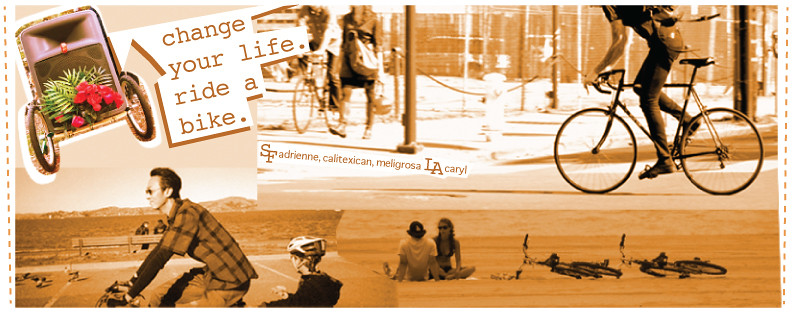By Mont Hubbard
Published in the Davis Enterprise, Feb. 26, 2010
San Francisco, early 1930s. In a time of much greater freedom and responsibility, a group of young teenagers called themselves the Blister Butt Bicycle Boys. My father-in-law Mal Taylor, 13, and his older brother Wally were founding members.
The bicycle was both emblematic of their independence and the key to it. They lived on their bicycles, the anvils on which the steel of their characters was forged.
The purpose of this column is to share some of the joy and excitement that youth in days gone by were afforded through their bikes. Modern equivalents must be happening in Davis today, and likely more can, but I just hope all of them are a bit safer.
Mal and Wally Taylor grew up in the Sunset district of San Francisco. Wally was born in 1920, and Mal the following year. Then as now, cycling in the city of San Francisco was considerably more challenging than in Davis. Hills, big hills, steep hills! How was a kid to get a heavy one-speed bike to adequately serve for transportation in such a situation?
Easy! With ingenuity, initiative and scavenged construction rebar, they carefully handcrafted a hook (see photo) and waited for an unsuspecting passing truck. (Kids, don’t try this at home!) The good news was that 75 years ago the trucks climbed very slowly up SF’s famously steep hills. The bad news was that they often accelerated going back down!

Mal
Taylor, top, and his brother Wally are pictured in the mid-1920s in San
Francisco, hinting at the fun they would have as Blister Butt Bicycle
Boys.
The self-fashioned hook was critical to quickly and effectively latching onto whatever part of the rear of the truck could be used for the tow, and then the hook ensured the essential quick release before the truck’s descent. Even with the “safety” features provided by the hook, Mal recounted one incident in which a rope dangling from the truck to which he had hitched became entangled in his bike’s front wheel, winding tighter and tighter. Fortunately, before the downhill slope it somehow unwound, freeing him before catastrophe could occur. The truck driver remained oblivious to the drama unfolding behind him in his blind spot.
Mal
Taylor and his brother Wally used this hook fashioned from rebar to
snag a truck that would tow their bike up the hills of San Francisco.
They had convinced their parents that the 6 cents a day it cost to support each of them at home should instead be devoted to financial support of their trip. That, together with their wages from odd jobs such as mowing lawns, helped to bankroll these expeditions.
The next summer the club decided on a 150-mile, five-day expedition to the Russian River. Having found homemade saddlebags too clumsy, they paid 63 cents (a substantial sum during the height of the Depression) to mail their packs to a nearby general store and made the trip to their camp in one day. This was one of many such trips: south to Big Basin, and by ferry to the East Bay hills and points north of the Golden Gate.
Little did they know that the independence, ingenuity and can-do spirit their bikes fostered would help them, a short decade later, to develop into the saviors of freedom of the Western world, as members of America’s Greatest Generation.
Although our 13-year-olds grow up in a completely different world today, they could still benefit from some of the unparalleled advantages that bicycles afforded the Blister Butt Bicycle Boys: physical and mental conditioning, initiative, self reliance, a bit more independence, and an unmatched sense of freedom and potential.
These are qualities that are not developed or enhanced by being driven to and fro in automobiles by parents. Bikes also provide a great introduction to mechanical devices — a vanishing area of knowledge for our youths in the age of video screens and electronic devices.
After hearing these stories, my wife Lyn, Mal’s daughter, feels extraordinarily lucky to have been born at all. But she observes that, even with modern improvements such as gears, helmets, lights and our excellent bike infrastructure, it’s reassuring not to have to use the truck hitching hooks in Davis.
— Mal Taylor (1921-2010) lived in Sunnyvale and enjoyed sharing the tales of his youth and biking with friends and family. Mont Hubbard is a professor of mechanical and aerospace engineering at UC Davis and a member of Davis Bicycles! He does research on bicycle dynamics and control and lives with Lyn in South Davis where they have raised four children and are trying to increase their bicycle travel mode share. To offer a Davis Bicycles! column, write to Joe Krovoza at column@davisbicycles.org






Great story! I used to go off on long trips like that in high school - I was yanked out of gym class the last two years of high school, so I would just leave on my bike on the weekends. I'd get too far off to get back by dark and call my mom with "Well, I don't know exactly but there are Amish buggies on the road here, I'll just hitch a ride back with someone who has a van or truck!" That always got them motivated to drive the 50-100 miles out to pick me up!
ReplyDeleteI just don't see kids doing that sort of thing now - the Bay Area doesn't really seem conducive to that sort of thing with all the traffic, and it seems parents are much more restrictive about what kids can do off on their own.